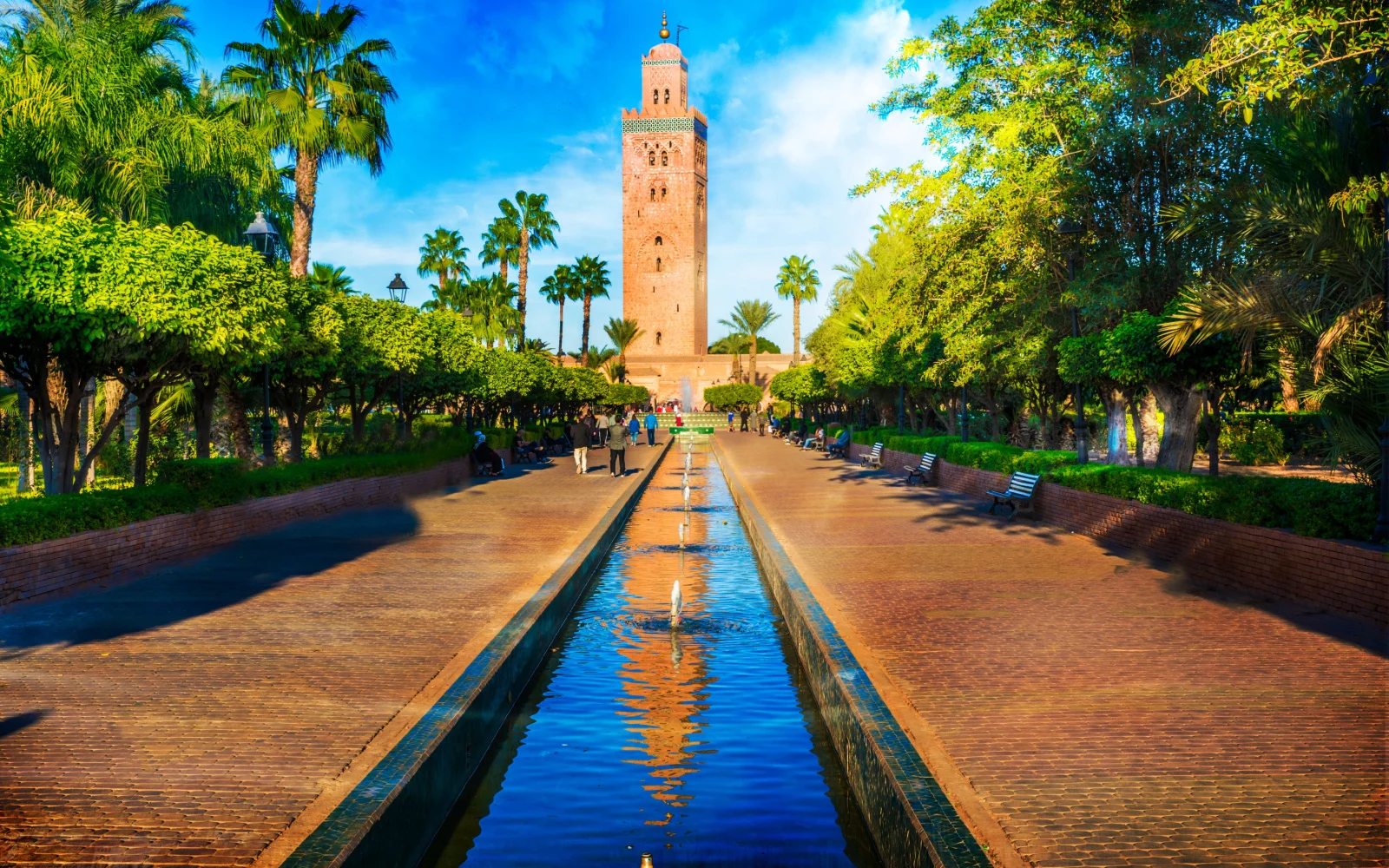Taking an Arabian adventure in the fascinating land of the setting sun soon? Discover the best places to visit in Morocco, from its exotic, historic cities filled with mosques and souks to the Sahara Desert region, separated from the stunning Mediterranean and Atlantic coasts by the rugged Atlas Mountains.
Morocco is an immersive destination with so many places on its map that will captivate and intrigue you. Let’s take a look at the 18 best places to visit in Morocco next!
18 of the Best Places to Visit in Morocco
You can have a range of experiences when visiting Morocco, but the best trips to this Arabian country in North Africa involve a little bit of everything: Sightseeing with ancient architecture and famous mosques, adventuring in the varied landscapes, and lounging on warm, sunny beaches.
Here are our favorite places to visit in Morocco — we think you’re going to love them, too.
1. Marrakech
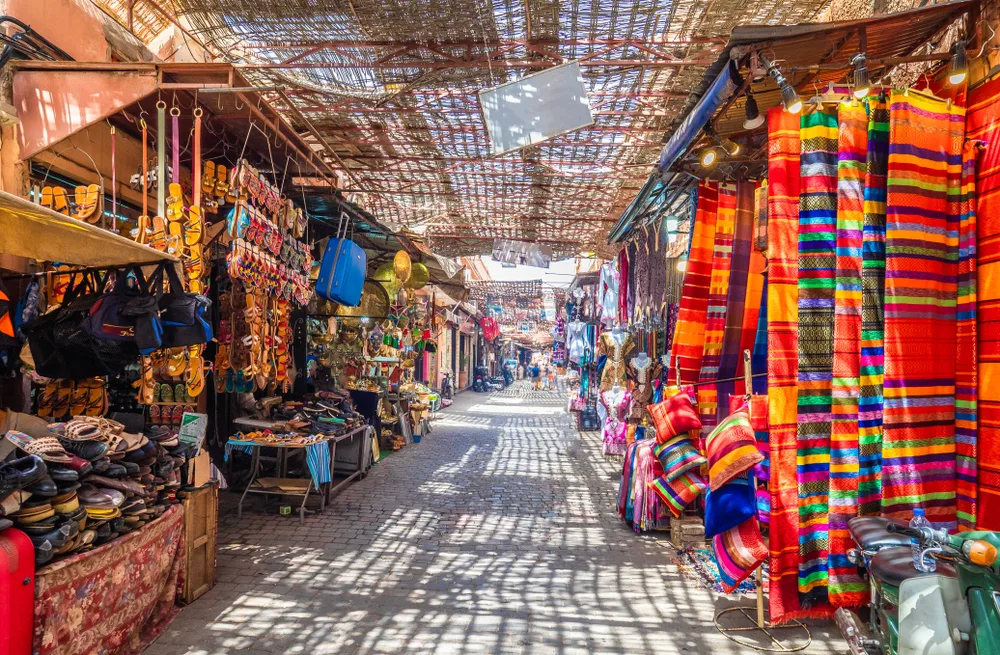
Balate Dorin/Shutterstock
As one of Morocco’s 4 historic capitals and imperial cities, Marrakech is a popular destination because it offers an excellent glimpse of the country’s melting pot culture, teeming with Arabian, Spanish, and African influences that you’ll see in its food, markets, festivals, and architecture.
Stay in a traditional riad, a traditional palatial guesthouse with its own courtyard, to really immerse yourself in Marrakech. They’re scattered throughout the city, especially around its medina (Old Town), where you’ll want to spend the majority of your time.
The medina features a maze-like network of narrow, cobblestone streets flanked by thick-walled, ancient buildings and mosques that add an exotic flair to your travels.
Visit the intricately-tiled Bahia Palace and the ruins of El Badi Palace, and marvel at the 12th-century Ben Youssef Mosque before haggling your way through the souks for patterned carpets, leather goods, jewelry, and spices.
Read Next: The Best Time to Visit Marrakech in 2025 & Where to Stay in Marrakech
2. High Atlas Mountains
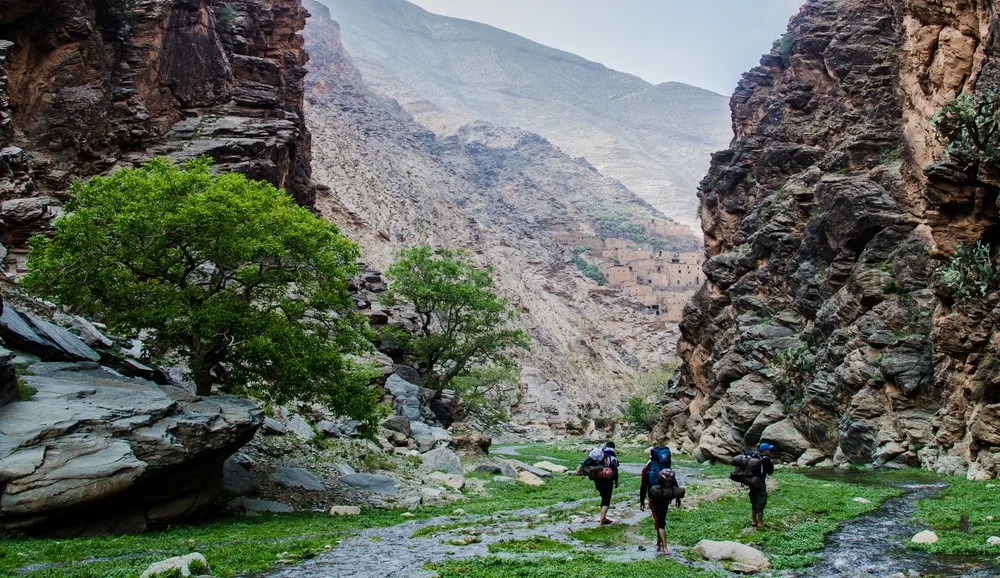
Rachid Baddah/Shutterstock
Morocco’s range of landscapes makes it an awesome destination for mountain climbers, hikers, and skiers seeking adventure at high altitudes. The Atlas Mountains’ highest peak, Toubkal, sits in central Morocco and its surrounding national park is a popular place to climb and hike.
You’ll overlook green valleys on mountain paths, passing by the Amazigh villages that have survived in the mountains for centuries, untouched by the modern world in their elevated refuge. Rent a 4×4 to drive the rugged roads with beautiful views, or opt for a real adventure by taking on the 3-day climb up Toubkal.
If you’re visiting during the winter (January through April is the best time for snow), slap on some skis and head to Oukaimeden, the biggest ski resort in the Atlas Mountains just a short trip from Marrakech. You’ll find hotels and state of the art facilities here for the ultimate ski vacation.
3. Draa Valley
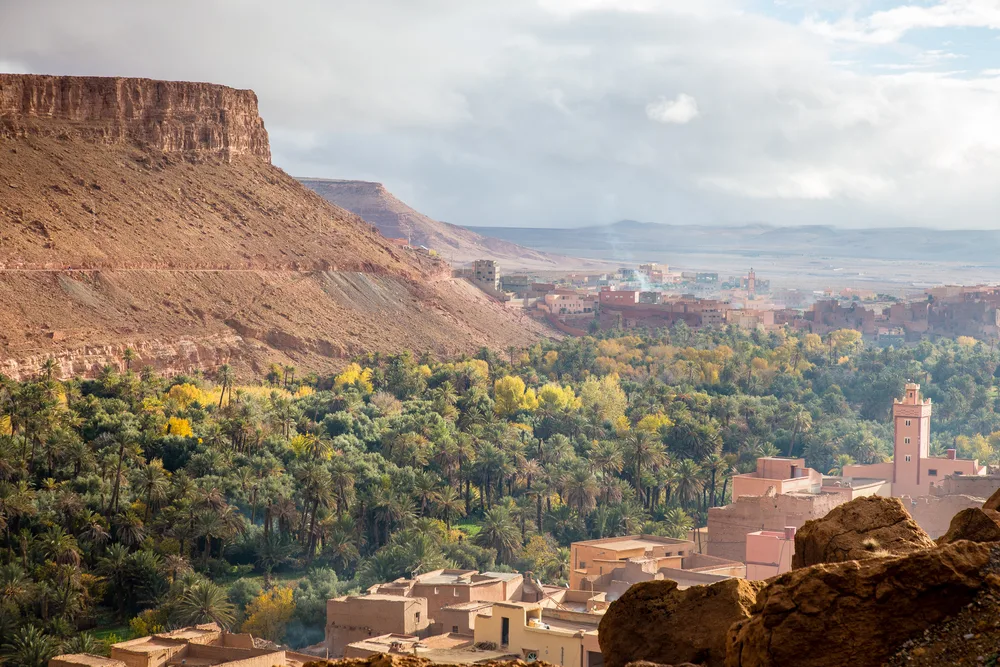
Javier Hueso/Shutterstock
Who hasn’t dreamed of visiting a desert oasis? In Morocco’s Draa Valley, that’s exactly what you’ll experience: An unbelievably lush valley of date palms loaded with the sticky-sweet fruits, traditional earthen architecture with ksur and kasbahs (villages and homes), all surrounded by the dunes of the Sahara and snowy peaks of the Atlas Mountains.
Berber villages populate the lush valley that runs from Ouarzazate to Zagora, and you can take the Circuits Touristiques route all the way through this stunning desert oasis on your way to explore the Sahara’s sandy stretches and water-starved landscapes.
One of our favorite things to do in the valley is visiting the Tizgui Waterfalls, formed where the river that creates the lush oasis flows over a cliff and plunges into a natural pool where you can go for a refreshing swim, surrounded by fig and palm trees.
Take a 4×4 vehicle to drive along the trails that meander along the river, leading you right into the adobe architecture and great views of the valley before heading back to Zagora. The scenery here is absolutely breathtaking.
4. Chefchaouen
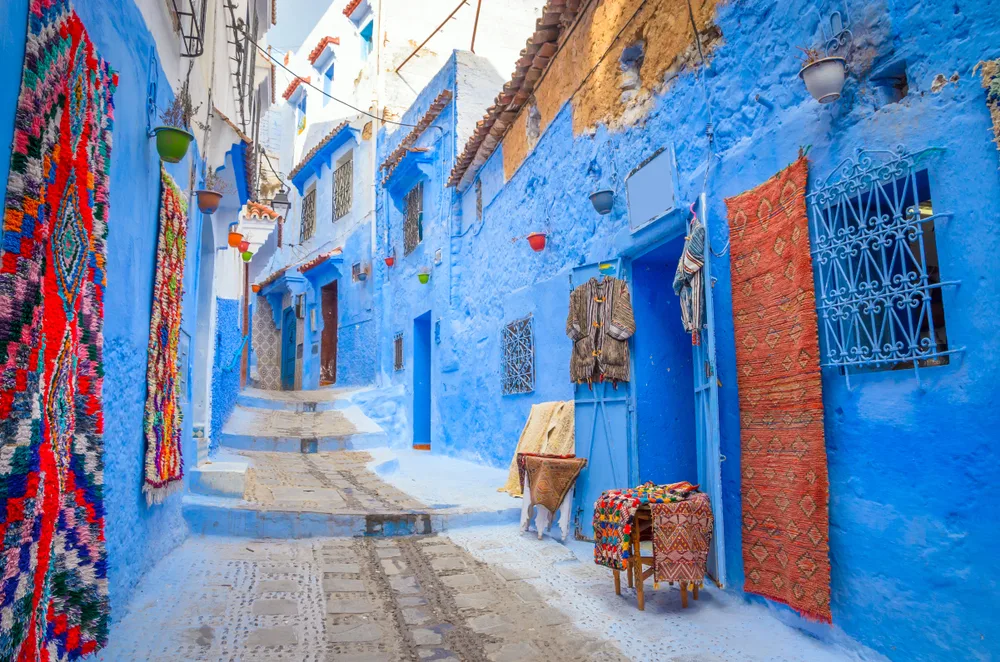
Olena Znak/Shutterstock
Chefchaouen is nothing if not colorful and historic, and it has both of these characteristics in spades. Once fortified heavily to protect against Iberian invasion, this city is recognized by UNESCO for its history and makes a great place to visit when you’re venturing across Morocco.
The Blue City, as it’s called, is a little different from the other towns you’ll visit in Morocco. It’s medina, or Old Town, is easily recognizable with its brilliant blue walls, the proud Kasbah of Chefchaouen, and cobblestone alleyways that are lined with hung colorful, patterned carpets and tapestries.
Wander the narrow streets that exude Arabian charm and stop into traditional Moroccan restaurants just beyond the walls of the medina for a true taste of the country’s flavors and spices (and a cup of mint tea).
You’ll want to visit the Lina Ryad and Spa for a stress-relieving massage or to indulge in the traditional Moroccan hammam, where you’ll be pampered, scrubbed, and exfoliated to emerge squeaky-clean and relaxed.
5. Valley of the Roses
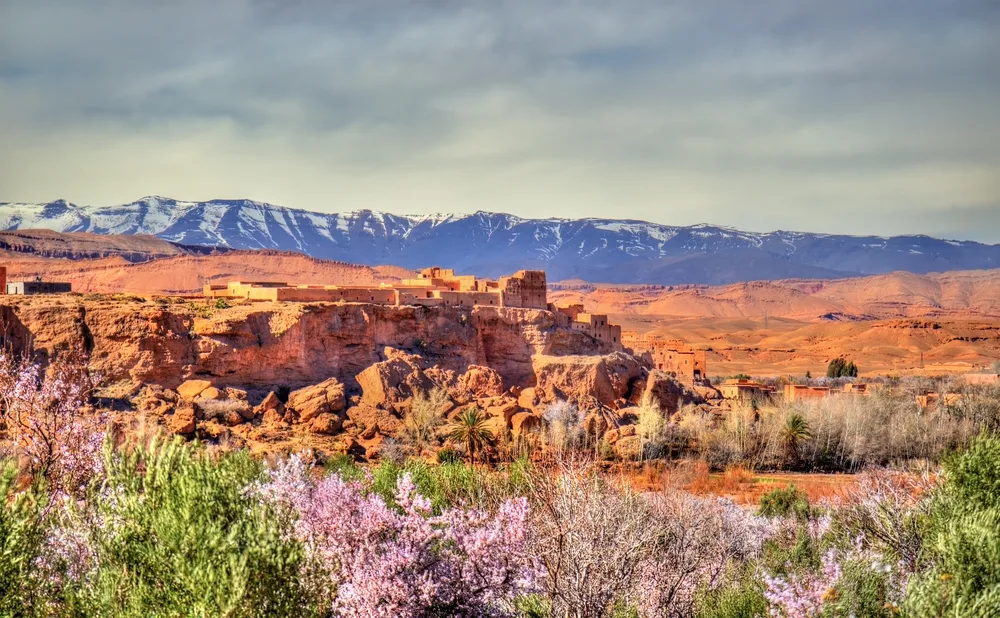
Leonid Andronov/Shutterstock
If you visit during April or May, you’ll smell the sweet, delicate fragrance of Morocco’s Valley of the Roses before you see it. This lush river valley in the Atlas Mountains is heavy with wild roses that grow along the valley floor and offer an intoxicating aroma along with beautiful, bloom-filled views.
On the way from Ouarzazate to Dades Valley, the Valley of the Roses is a convenient stop that’s easy to reach with well-paved roads that lead you directly into the heart of the valley and its charming shops, eateries, and natural landscapes.
The valley feels and looks like a desert oasis, surrounded by stepped rock formations and desert sands in an amazing contrast to the deep greens and brilliant pinks and reds of the rosy haven. The Assif M’Goun River is the valley’s lifeblood.
Take the scenic drive down the riverside road into the heart of the valley, where you’ll find souks, shops, and traditional eateries. The roses here are picked and transformed into sweet-smelling goods and treatments, which you can pick up (and tour the rose oil distillery) in Kalaat M’Gouna at Rosa Bio or Laboratoire HÉVÉA to sample for yourself.
6. Ait Ben Haddou
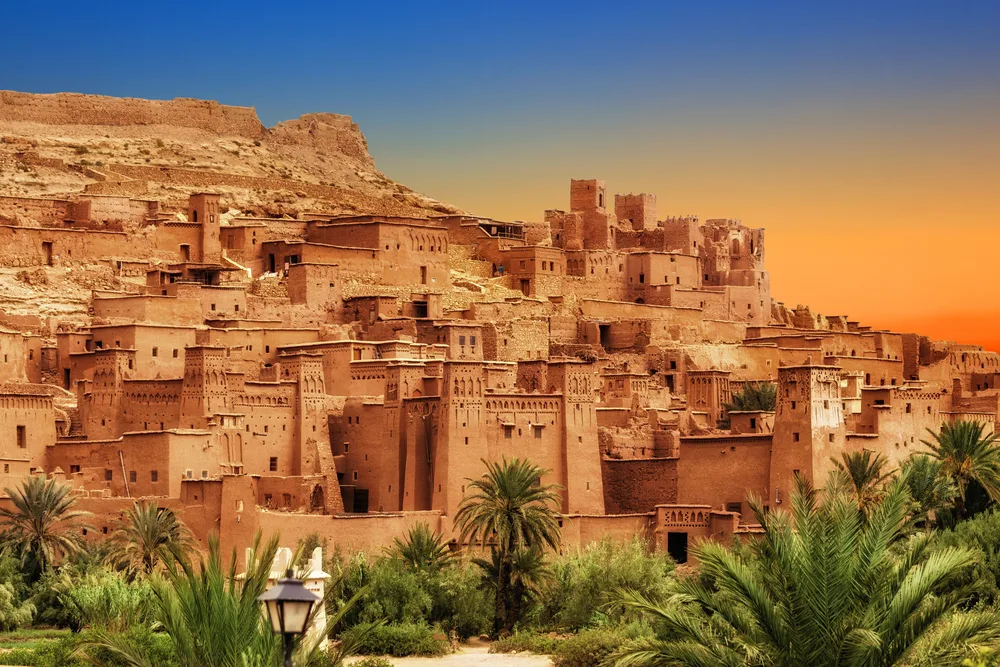
Ivan Soto Cobos/Shutterstock
High-walled, clay buildings and towers shaped in squares and trapezoids with amazing detail makes Ait Ben Haddou visually striking. This group of buildings is collectively known as the ksar, and its purpose is historically defensive with homes crowded together and flanked by high towers.
The unique Southern Moroccan structures of Ait Ben Haddou, located in the Ouarzazate province among the High Atlas Mountains, date back to the 17th century. The impact is incredible as you arrive to the historic village with mountain peaks surrounding you.
The trapezoid-shaped towers rise on the sides of the clay-fashioned homes with thick walls, appearing like fortresses in the same desert-gold color scheme as the surrounding landscape.
Once an essential stop on the Marrakech trade route, today you can wander through the old main square and see a mosque, ramparts, cemeteries, and the Sanctuary of the Saint Sidi Ali on the edge of town. You might recognize this village as the “Yellow City” on Game of Thrones or from scenes in Gladiator!
7. Agadir
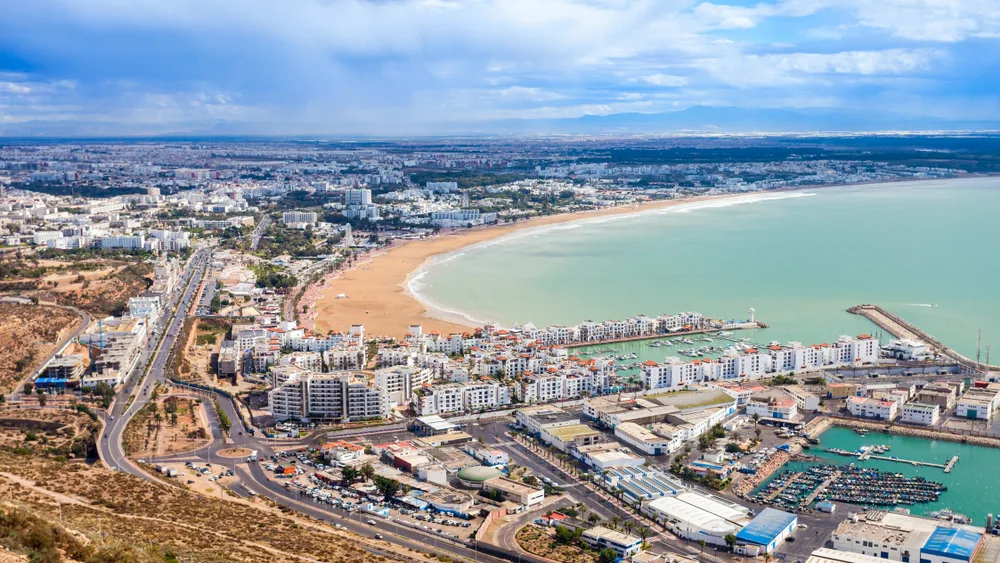
Saiko3p/Shutterstock
When you’re ready to shun the desert landscapes and embrace the rich, coastal flair of Morocco’s beaches, head to Agadir. This town is situated in the foothills of the Anti-Atlas Mountains on the southern Atlantic coast of Morocco and is a haven for rest and relaxation.
Agadir isn’t a place with a lot going on — you’ll come here to unwind on the sandy shores, engage in water sports, or wander through markets when you’re ready to get off the beach. But it’s an ideal spot to visit after a stay in a more hectic area, like Marrakech.
You’ll find golf courses, a serene crescent-shaped beach, and plenty of places to grab traditional Moroccan food at cafes and restaurants lining the beachfront. Take a quick cable car ride up the hill to see the crumbled remains of the Kasbah Agadir, once ravaged by an earthquake.
Agadir’s main beach is great, but you’ll find even more coastal coves to explore further north, like Taghazout, or south, like Tifnit. You won’t have trouble finding a hotel (they’re all along the shore), and take an afternoon to explore the old souk market, Souk El Had d’Agadir, with over 6,000 shops for souvenirs and spices.
8. Casablanca
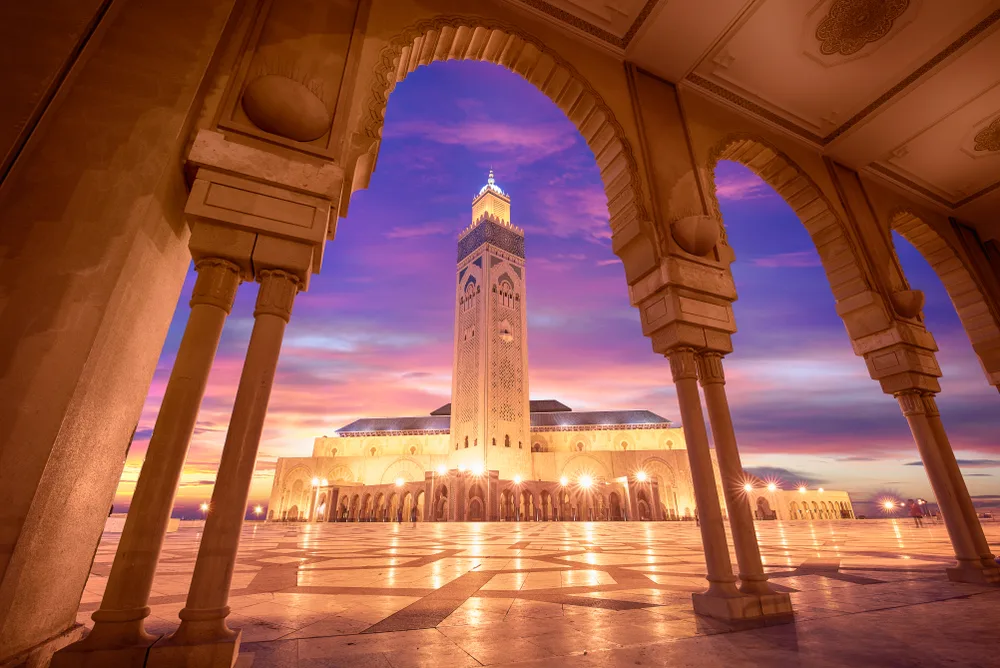
Casablanca, Morocco – 20 June, 2019: The Hassan II Mosque at the night. The largest mosque in Morocco and one of the most beautiful. the 13th largest in the world. Shot after sunset at blue hour/Mitzo/Shutterstock
French-colonial and Neo-Moorish architecture with proud mosques and a maze-like medina make Casablanca stand out as a truly Moroccan city, bustling with life, sound, and delicious aromas along its seaside location on the Atlantic Ocean.
It’s not a popular tourist destination, but for many travelers, that’s part of the charm. When you’re here, the main attractions are visiting Casablanca’s mosques — especially the ornate Hassan II, the largest mosque in Africa and 14th-biggest in the world — and markets.
The Old Town medina souks in Casablanca are busy, crowded, and hectic with lots of haggling and offers going on. You’ll be able to smell and taste Moroccan dishes and street food from the stalls, browse hand-made and “name brand” goods in the tent shops, and get a glimpse of local life.
You can visit a traditional Moroccan hammam, wander along the small network of streets and alleys in the Old Town, and check out the plaza by the coast to take a few pictures. Watch out for the scooters — they zoom past and in the tiny, maze-like streets, you’ll need to keep your wits about you to avoid getting hit!
9. Rabat
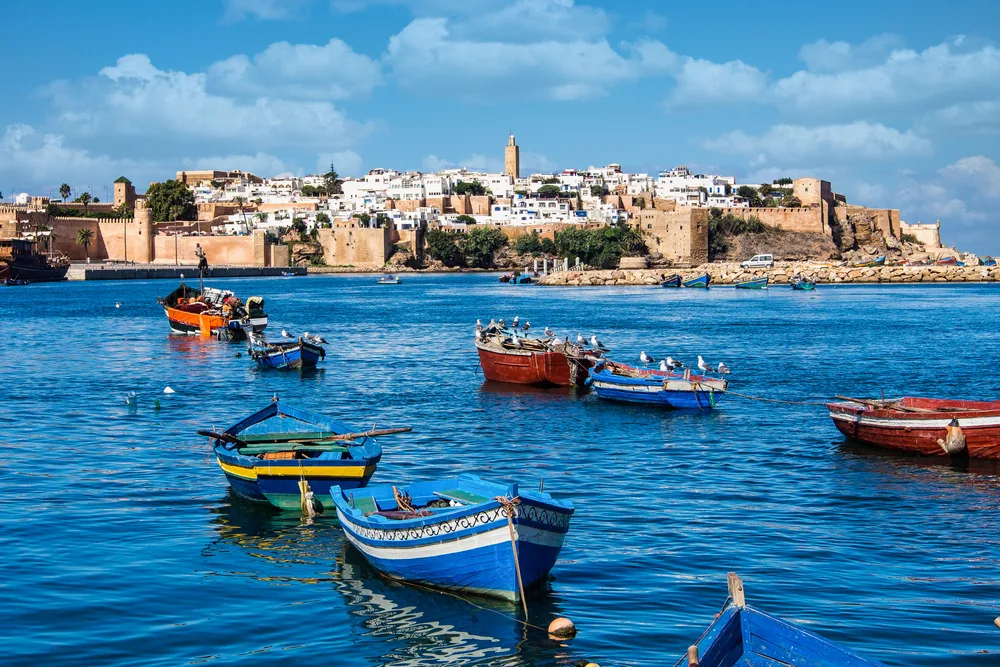
RudiErnst/Shutterstock
Rabat, the capital city of Morocco, has deep historic roots as an imperial city and is one of the most charming places you can visit in the country. Intricate Moroccan tiles, cobbled stone streets, colorful tent markets, and amazing architecture with mosques and minarets make it a fascinating stop on your trip.
You can see the French and Islamic influence in the buildings and lush gardens here, like the Kasbah of the Udayas fort and incomplete, 800-year old Hassan Tower. Traditional Moroccan tiles in mosaic fashion around fountains and monuments are truly inspiring to see.
The Kasbah of the Udayas features a small cafe, the Moorish Café, where you can sip mint tea like a local as you look out over the ocean after exploring the royal fort’s opulent grounds and Andalusian gardens. Visit the Hassan Tower and check out the Mausoleum of Mohammed V at its base, decked out with traditional artwork and intricate white onyx carvings.
The Old Town medina, the Chellah, in Rabat is one of the best in the country, with travelers arriving here just to walk its labyrinthian streets and browse the millions of items for sale. Bab el Had Square has gorgeous fountains and a gate from the 12th century, while the medieval-era Great Mosque overlooks it all.
10. Sidi Ifni
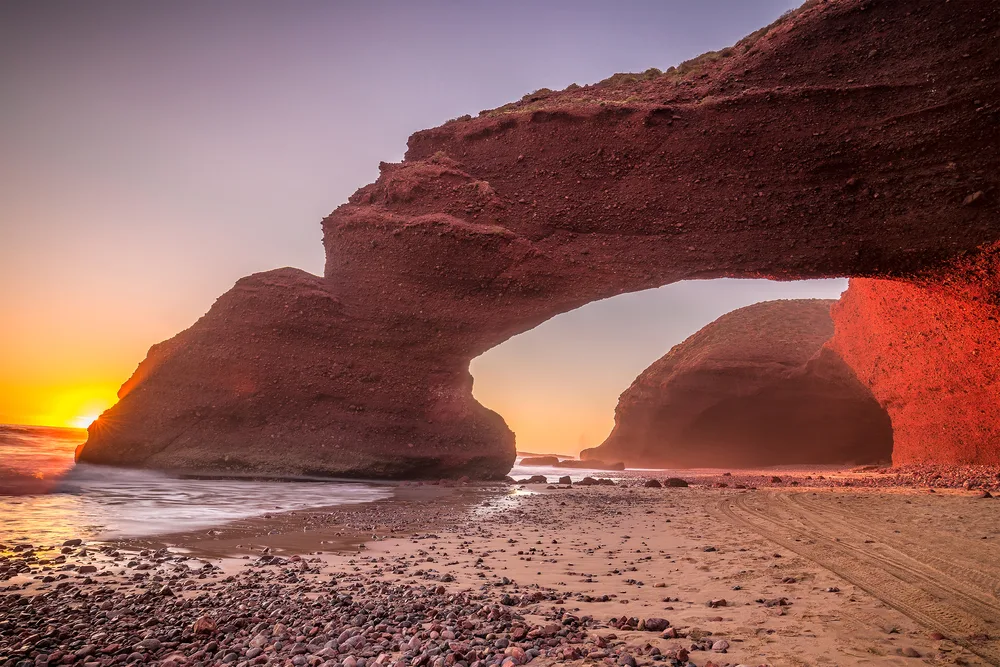
RuslanKphoto/Shutterstock
Sidi Ifni is an interesting glance at Spanish influence and architecture in the heart of a Moroccan city, but it’s just as well-known for its massive cliffs and rock formations on the coast that make you feel tiny by comparison.
Originally founded by Spain in the 1930s, Sidi Ifni came under Moroccan rule in 1969. It’s Spanish architecture was here to stay, however (for the most part — some buildings were torn down), and today, it’s an amazing fusion of Spanish and Moroccan styles.
You’ll see examples of rationalist and Art Deco style in the buildings here, making you stop and question where you are. The area is fringed by fertile farmland and nice beaches, which make one of the best places to visit in the city if you’re looking to feel dwarfed by natural landscapes amid towering cliffs and keyhole rock formations on the water.
Admire the seaside hills and rock formations at the beautiful Mirleft Beach. Legzira Beach is where you can surf the famed “la droite” wave and attend surf school if you’re a beginner, surrounded by those amazing rock forms that give the beach an almost-alien vibe.
11. Meknes
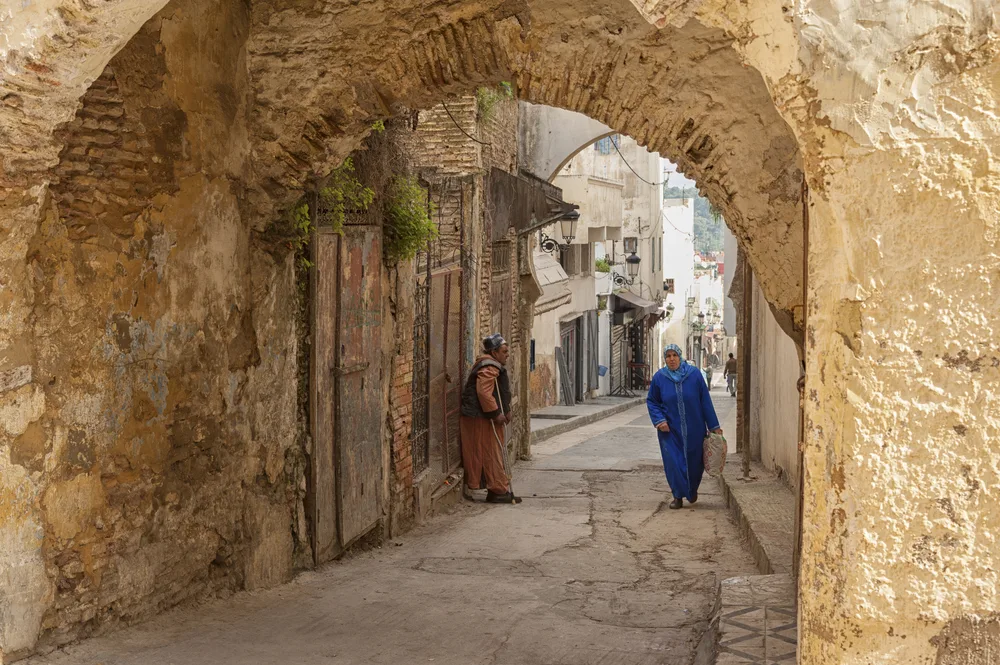
MEKNES, MOROCCO – FEBRUARY 18, 2017: Unidentified people walking in the street of Meknes, Morocco. Meknes is one of the four Imperial cities of Morocco/Laura Facchini/Shutterstock
In northern Morocco, Meknes (a former imperial city) is known for its massive, tiled entry gate built in the 17th century. Called Bab Mansour, it separates the Old Town of the city and the bustling market square from an opulent palace and its sprawling grounds.
People love to visit Meknes’ Lahdim Square, a buzzing plaza where vendors and sellers pack themselves into stalls with delicious aromas of Moroccan food and snacks, tables full of glistening wares, and snake charmers playing music to sharp-eyed serpents.
On the other side of the gate, there’s the opulent palace complex of Sultan Moulay Ismail, called the Kasbah of Moulay Ismail, which has been standing in its place since the 1670s and houses the ruler’s mausoleum, fountains, and gardens.
Visit the Dar Jamai Museum (located in a 19th-century palace) while you’re in town to learn about the history, past rulers, and culture as you look at artwork, historic relics, and archaeological artifacts from the area’s past.
12. Asilah
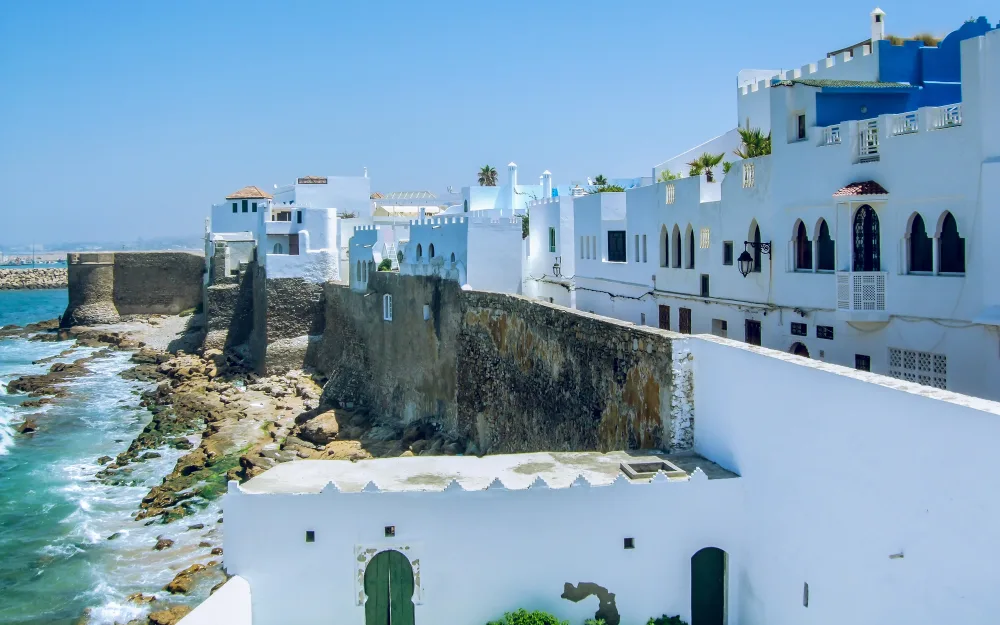
Jose Carlos Serrano/Shutterstock
Come visit Asilah, a fortified beachfront town on the Atlantic Ocean with a prominent Old Town medina, a thriving art culture, and great beaches to relax and play on while you’re spending a few days here.
You’ll find late medieval-era buildings packed into the walkable Asilah medina, which has been encircled and protected since the 15th century by Portuguese-built massive gates and ramparts. This old district is focused on art and creation, with locals freely painting colorful, impressive murals on the once-white walls.
You’ll marvel at the cool doors, shaped like keyholes, in the Old Town, but entering the Ville Nouvelle (New Town) is where the town opens up with eateries, hammams, neat shops, and massive bazaars where you can find just about anything for sale. Check out the Moorish-style Church of San Bartholomew here.
Port Beach and Medina Beach are both options if you’re up for a little sand and sun, both offering shallow water that’s nice to swim and play in on a hot day. Wander down to the Krikia stone pier/jetty south of the medina and get a view of the ramparts overlooking the ocean.
13. Essaouira
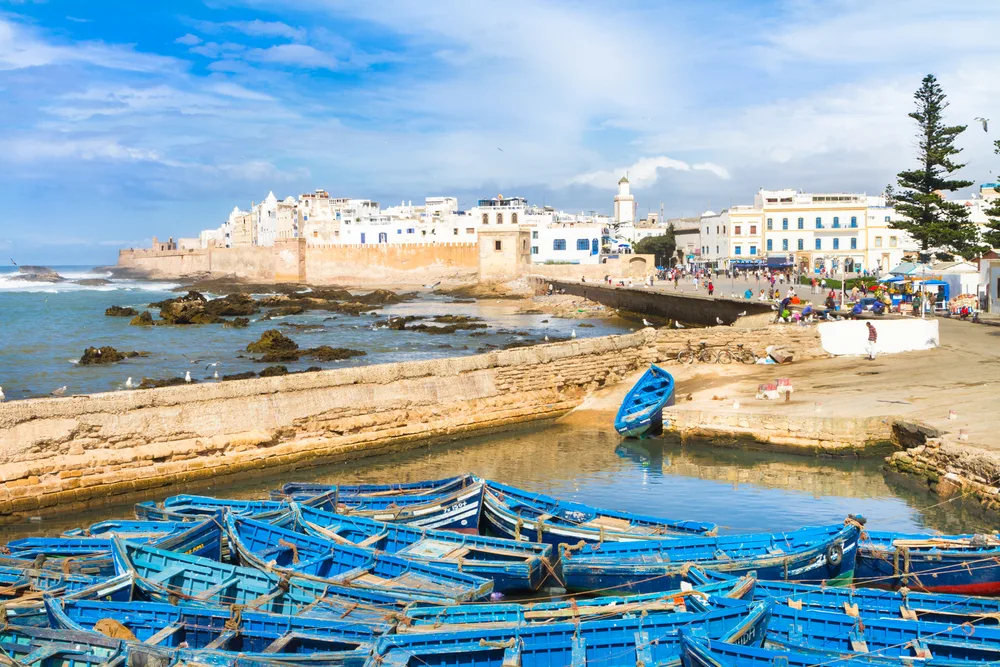
Matej Kastelic/Shutterstock
On Morocco’s Atlantic coast sits the natural port city of Essaouira, a surfer’s paradise with a bustling medina, interesting history in the Jewish Quarter, and ample opportunities for adventurous activities like kitesurfing and horseback riding.
The city’s history is apparent when you first arrive and see Skala de la Kasbah, the thick, stone-paved coastal walls, or ramparts, overlooking the Atlantic with giant arches. There’s a line of brass cannons in front, and coupled with the amazing waterfront views, it’s a fascinating part of the city to check out.
Essaouira is a windy city, on the receiving end of strong trade winds that kick up the waves and make the beaches an absolute hub for surfers of all skill levels. Windsurfing and kitesurfing are also popular sports if you’re not quite sure about getting on a surfboard.
The old medina is lined with opulent riads flanking narrow streets, lending a charming, historic vibe to the city. Head to art galleries, eat lunch at a rooftop cafe, and take a quad or horseback riding tour to get to know the lay of the land and make your way along the coast.
14. Fez
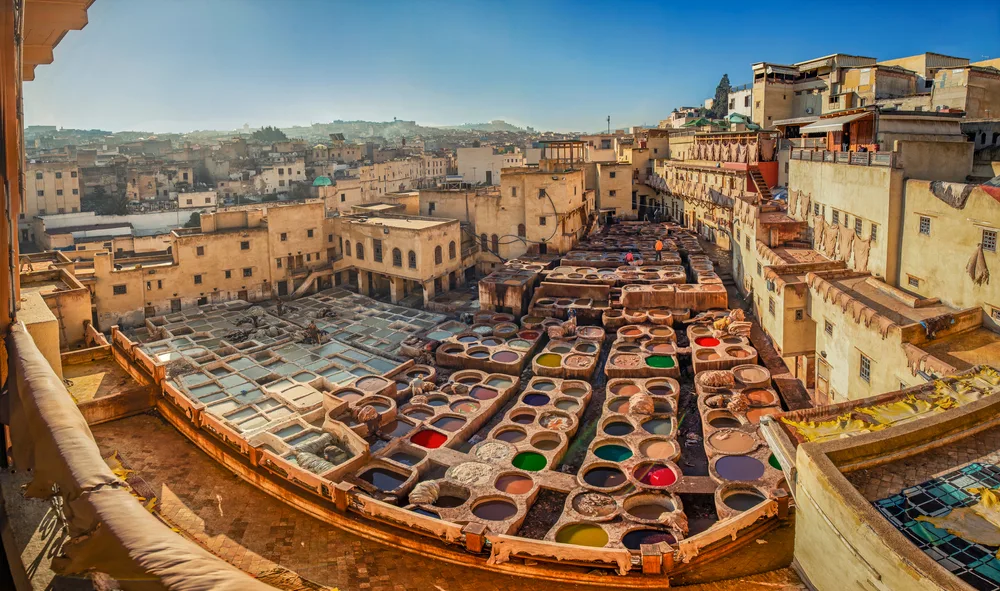
Milton Louiz/Shutterstock
The former capital of Morocco, Fez (or Fes) is still an important city in the country and features some of the coolest, traditional Moroccan and Berber architecture, an ornately designed city gate (Bab Bou Jeloud), and a city rich in Moroccan culture with international influences.
The medina is the most famous part of the city, called Fes El Bali. It’s a walled complex in the heart of Fez with Marinid-style architecture from the medieval era contrasted with vibrant souk markets, like Souk al-Attarine, set up along the stone-paved streets selling perfumes and aromatic spices.
Look for 14th-century schools that are designed with intricate carved cedar wood and traditional Moroccan tile while you walk. This is where you’ll want to start your trip and spend a few hours touring. There’s also an old tannery, Chouara Tannery, where you can see traditional clay pots filled with leather dyes.
The Lido Market is a hotspot for readers, as one of the most famous used book markets in the country with endless titles being sold and swapped by sellers. You can even find rare books here — plan on spending an hour or more browsing!
When it’s time to grab a bite to eat, head to a rooftop cafe like O’clofk Cafe to get coffee and food made with authentic ingredients and flavors, from pastries and Moroccan eggplant salad to camel burgers.
15. Skoura
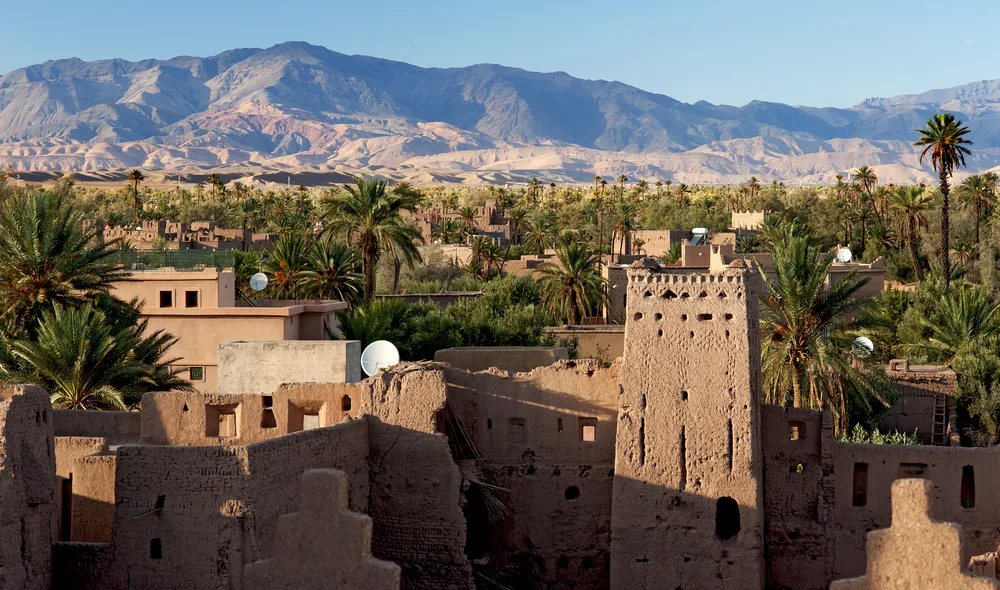
Philip Reeve/Shutterstock
Located in the Valley of the Roses, Skoura is known for its 17th-century earthen Kasbah fortresses and towers surrounded by lush date palm groves and desert-colored rocky hills. This naturally beautiful destination is one of the best in Morocco if you’re seeking a break from the hustle and bustle.
There’s both a modern and historic side to Skoura, making it a cool place to see the divide of both worlds and experience both authentic Morocco of today and the shadow of its past. Visiting the preserved Kasbahs with a guide will be the most enjoyable, and you’ll be able to learn about each structure’s history and role in the city’s defense.
Kasbah Amridil will be at the top of your list. It’s a castle-like fortress from the 17th century surrounded by the walls of the Old Town, and you can still see the bread ovens, oil press, and other signs of what life was like in those days.
Skoura Balades, the Skoura date palm grove, is another neat place to visit while you’re here. It’s a hiking destination with meandering paths that wind through the palms and up into the hills. You can even ride camels or mules through the groves and enjoy cheese, tea, and pottery workshops if you’d like.
Quad and horseback rides are a lot of fun in this area, so head to Janates Riam where you can schedule fun outings and other special activities, like lunch at a local’s home, outdoor dining, and museum and kasbah tours.
16. Tafraoute
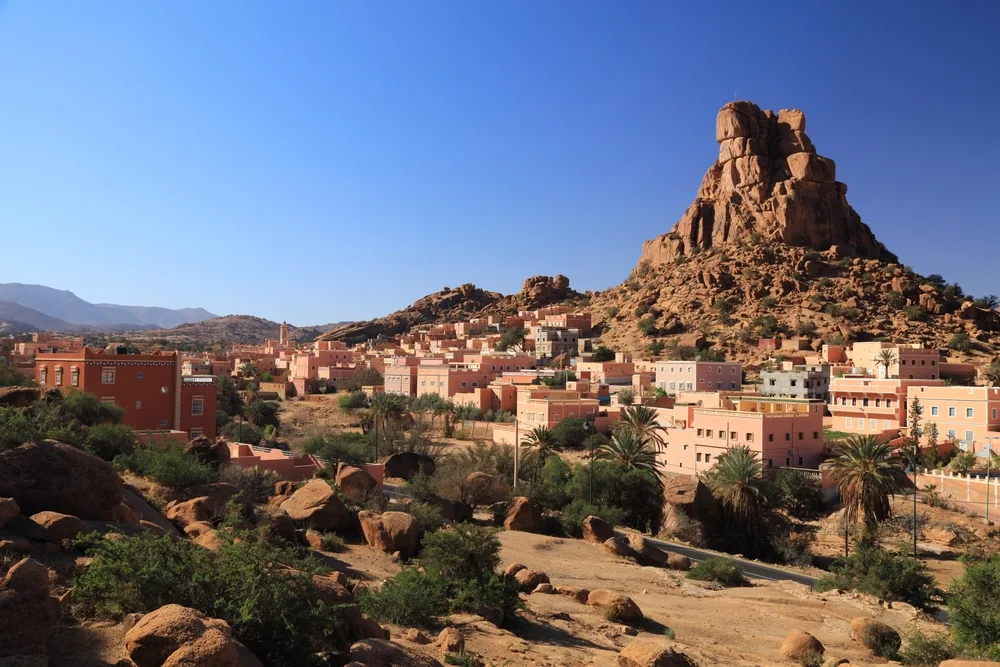
Tupungato/Shutterstock
Up in the Anti-Atlas Mountains, the town of Tafroute appears like a mirage out of the desert and offers an awesome place to spend a day sightseeing and exploring this historically and culturally rich little town.
This is Berber country in Morocco, being home to the Amazigh Berber peoples for centuries before the era of Arab rule. You’ll love seeing the unique little villages scattered through the groves of palm trees that spring up in the desert amid the backdrop of the rugged mountains.
People come here to hike, climb, and explore different tribal cultures, like the Amazigh people. Along the road to get here, you’ll pass Kasbahs sitting on hillsides in their historic glory, granaries, and tiny markets set up with wares like babouche slippers (a traditional garment to show marital status).
If you’re here on a Wednesday, you can browse the markets and pick up some souvenirs for yourself along with spices, fresh produce (including dates), and sweet-smelling perfumes. Check out the gazelle rock carving south of the city and the Maison Traditionelle village home to see what life looked like for Berber people in the past.
17. Tangier
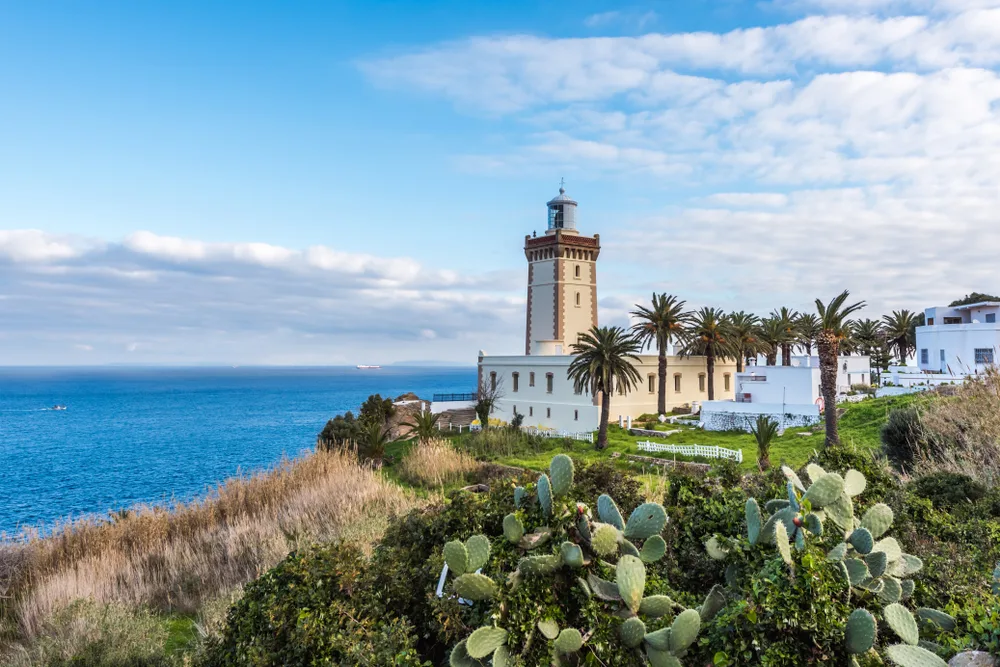
Rayints/Shutterstock
Tangier comes up often as one of the best places to visit in Morocco along the coast, and it definitely deserves the hype. The port city of Tangier sits on the prized Mediterranean coast of Morocco and offers a breath of fresh air with long-spanning history that dates back to the Phoenicians.
You can explore Hafa, where you’ll find dozens of (empty) Phoenician tombs resting high on a hill overlooking the sea, and head down to the blue and whitewashed medina to see a collection of old palaces, museums, and landmarks.
There’s Ibn Battuta’s Grave and the Moorish-style American Legation Museum detailing the Moroccan-American relationship to check out while you’re exploring the medina, and the Kasbah Museum houses relics, statues, and antiques from the region.
Take a stroll down the lovely Merkala Beach on the shores of the Mediterranean Sea before you visit Villa Harris Park with a gorgeous home that has been turned into a museum, and Rmilat park, where you’ll find Perdicarris castle, is a must-visit place with its own museum and incredible views.
18. Volubilis
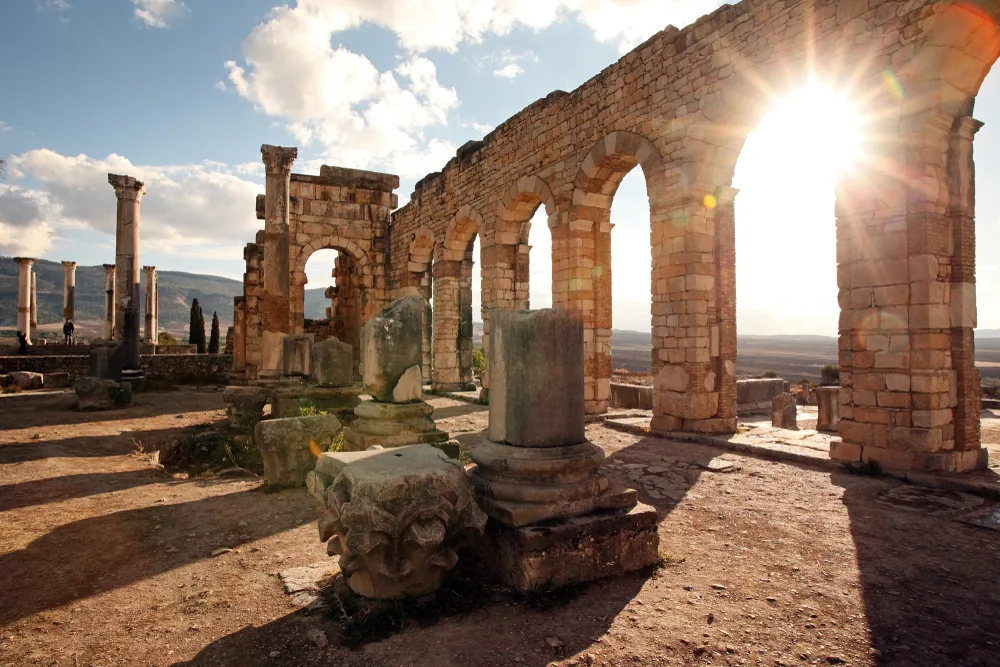
Akimov Konstantin/Shutterstock
Volubilis is a UNESCO World Heritage Site and Roman city that traces its history all the way back to the second century BCE. Today, ruins of the town are being slowly excavated and more and more of the city is being exposed. You can wander through the ancient ruins today and get a sense of daily life all those years ago.
Volubilis still features many of its homes, mosaic tiles, aqueducts and baths, temples, and ramparts that you can explore as a tourist on the edge of a massive plain beneath the Zerhoun hills in Morocco. There are many oil presses, which tell researchers that olive groves and oil were a major part of commerce in the history of the city.
The ruins are so impressive that they were once called “Ksar Faraoun,” meaning the castle of the Pharaoahs, and you can still see the ruins of the 8 city gates, old city walls, and the tumulus, or burial mound, built over them.
Researchers believe Volubilis might have been the capital of the Kingdom of Mauretania at some point, and it’s an amazing chance to wander the hallowed grounds of this ruined city if you’re visiting Morocco one day soon.
Frequently Asked Questions
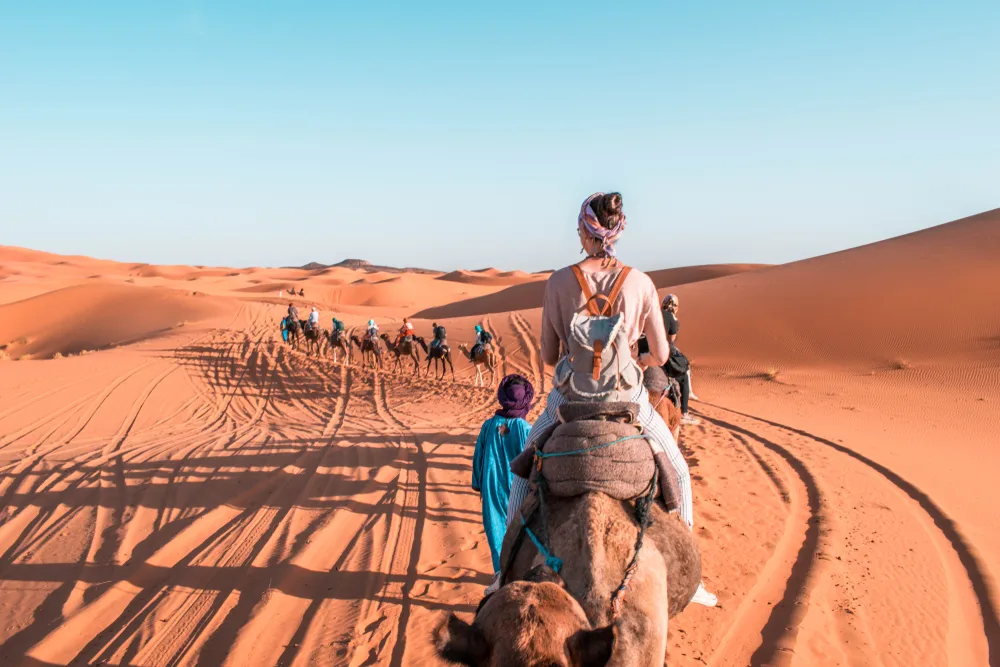
Aurelia Teslaru/Shutterstock
Armed with a list of the 18 best places to visit in Morocco, do you have some lingering questions? Take a look at the most common questions that Moroccan travelers have below to learn more!
What is the nicest place in Morocco?
The desert oases are some of the nicest places in Morocco, including those in the Draa Valley and Skoura in the Valley of the Roses. For beautiful beachfront luxury with lots of cafes, shops, and history, Morocco’s nicest places include Agadir, Sidi Ifni, and Tangier.
While some may consider it a bit boring, the city of Chefchaouen (the “Blue City”) is really nice, clean, and features prominent blue walls along its narrow streets and alleys in the Old Town medina.
What is the best city to visit in Morocco for the first time?
Marrakech is often recommended as the best city to visit in Morocco with its riads, amazing maze-like Old Town, and historic mosques, but it’s a busy city that’s often inundated with tourists. It can be a bit hectic for your first time in Morocco, but it’s definitely worth seeing.
If you’re looking for a more laid-back experience for your first time in the country, consider visiting Fez, Morocco’s unofficial cultural capital with lots of cool architecture, a thriving medina, and plenty of places to eat authentic cuisine and browse souk markets.
What city should I fly into in Morocco?
The Casablanca airport, Casablanca-Mohammed V, in Casablanca is the most-used airport in the country and where most international flights touch down upon arrival in Morocco. From Casablanca, you can conveniently reach popular destinations like Marrakech in about 3 hours by car.
What is the best city to stay in Morocco?
Marrakech is the best city to stay in while you’re visiting Morocco, and not just because it’s the most popular destination for tourists. Marrakech features a range of traditional riad guesthouses that offer a palatial feel and private courtyards, some with rooftop pools, that make your stay feel distinctly Moroccan.
You can choose riads located in and around the walled medina, or Old Town, to make visiting the labyrinthian streets and markets there more convenient during your trip.
Should I go to Marrakech or Casablanca?
Marrakech is more appealing than Casablanca, offering a better Old Town and more Moroccan architectural marvels to check out while you’re in town. Casablanca is a more modernized city that’s busier and more focused on daily life than tourism or honoring its history.
Still, Casablanca may offer more restaurants and features unique architecture with French-colonial and Moorish influences that make it a cool place to visit. If you can, visit both cities!
So, What Are the Must-See Places in Morocco?
From the most famous destinations, like Marrakech and the capital, Fez, to hidden gems along the coast and jaw-dropping Roman ruins, the best places to visit in Morocco are amazingly diverse and completely immersive.
Arabian, European, and African influences make visiting Morocco’s coolest destinations that much more fulfilling and engaging.
From the tasty foods and classic mint tea sips to wandering medinas that seem as old as time, guarded by old ramparts and cannons, your trip to Morocco is sure to leave you with lasting memories and a strong desire to come back as soon as possible!



